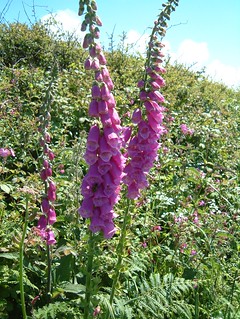Common Foxglove (Digitalis purpurea)
On this page... (hide)
- 1. Description
- 2. Obtainment
- 3. Cautions
- 4. More
- 5. 'Souls
| Common Name | Common Foxglove |
| Latin Name | Digitalis purpurea |
| Icon(s) |   
|
|
"Foxgloves 2" | |
1. Description
Digitalis purpurea is an herbaceous biennial or short-lived perennial plant. The foliage forms a tight rosette at ground level in the first year. The flowering stem develops in the second year, typically 1 to 2 m tall, sometimes longer. The flowers are arranged in a showy, terminal, elongated cluster, and each flower is tubular and pendent. The flowers are typically purple, but some plants, especially those under cultivation, may be pink, rose, yellow, or white.
2. Obtainment
Common. Digitalis purpurea was grown throughout the world as an ornamental plant in gardens by humanity. It is naturalized in Nova Scotia.
3. Cautions
- Poison: The leaves, flowers and seeds of this plant are all poisonous and can be fatal if eaten. Symptoms of Digitalis poisoning include a low pulse rate, nausea, vomiting, and uncoordinated contractions of different parts of the heart, leading to cardiac arrest and finally death.
4. More
5. 'Souls
- Skana Creo forced-fed and overdosed an assailant on foxglove to see its poisonous properties and for revenge purposes.

